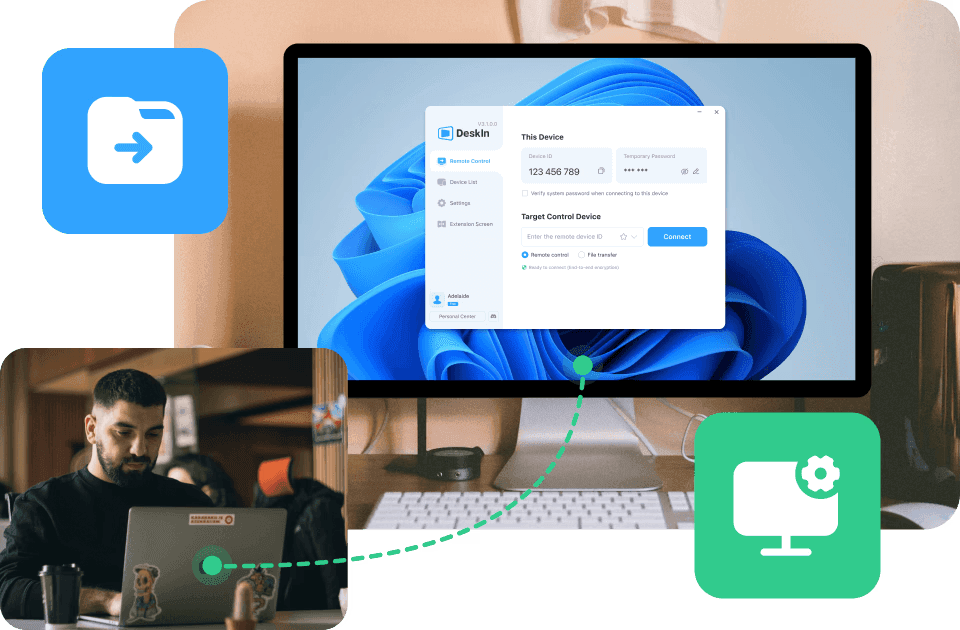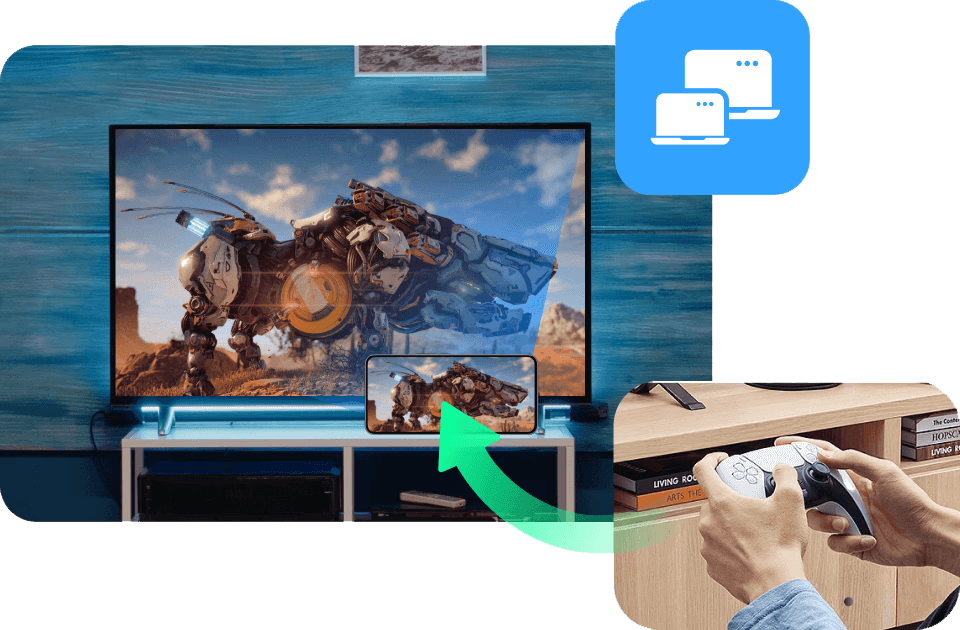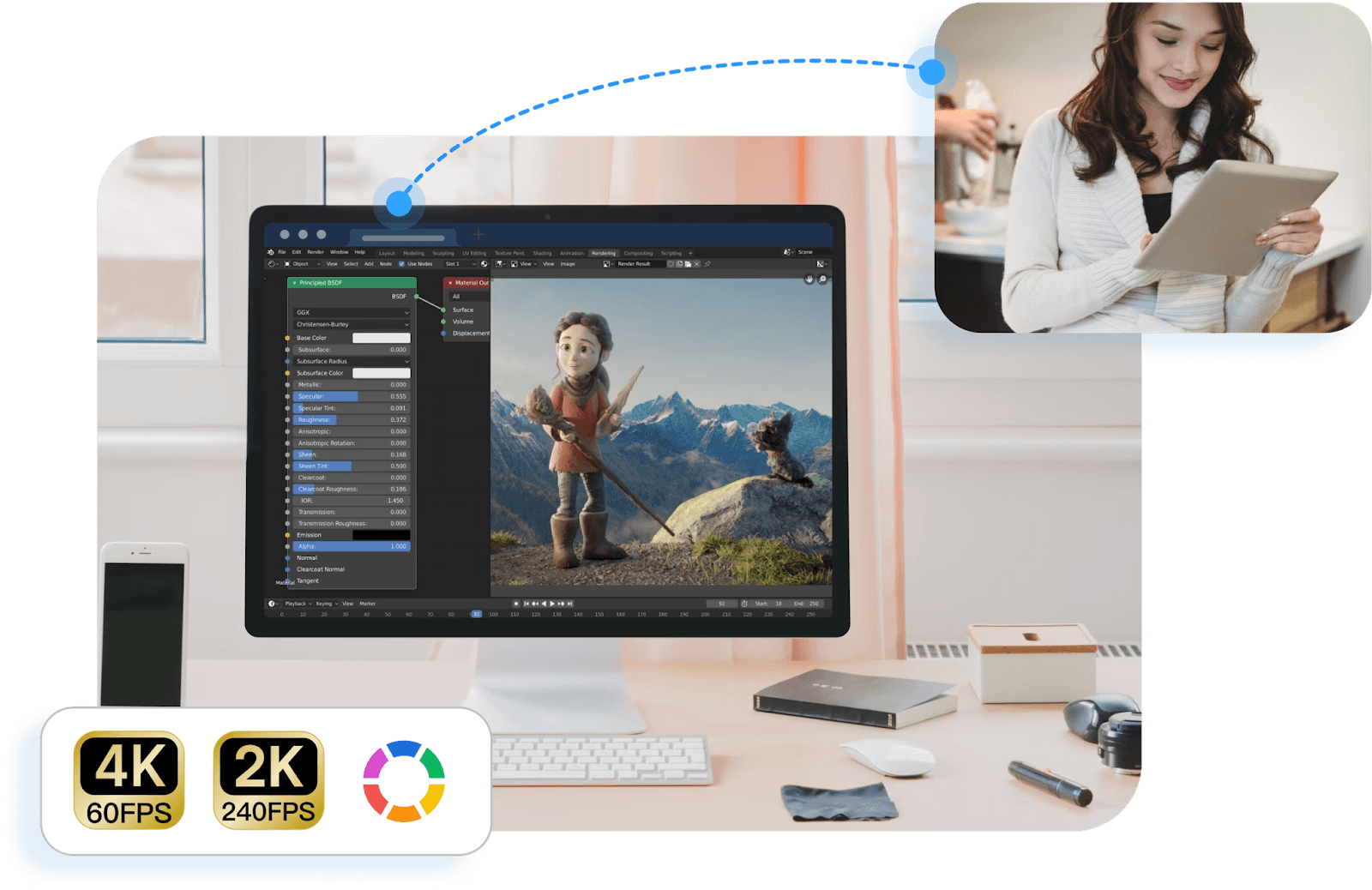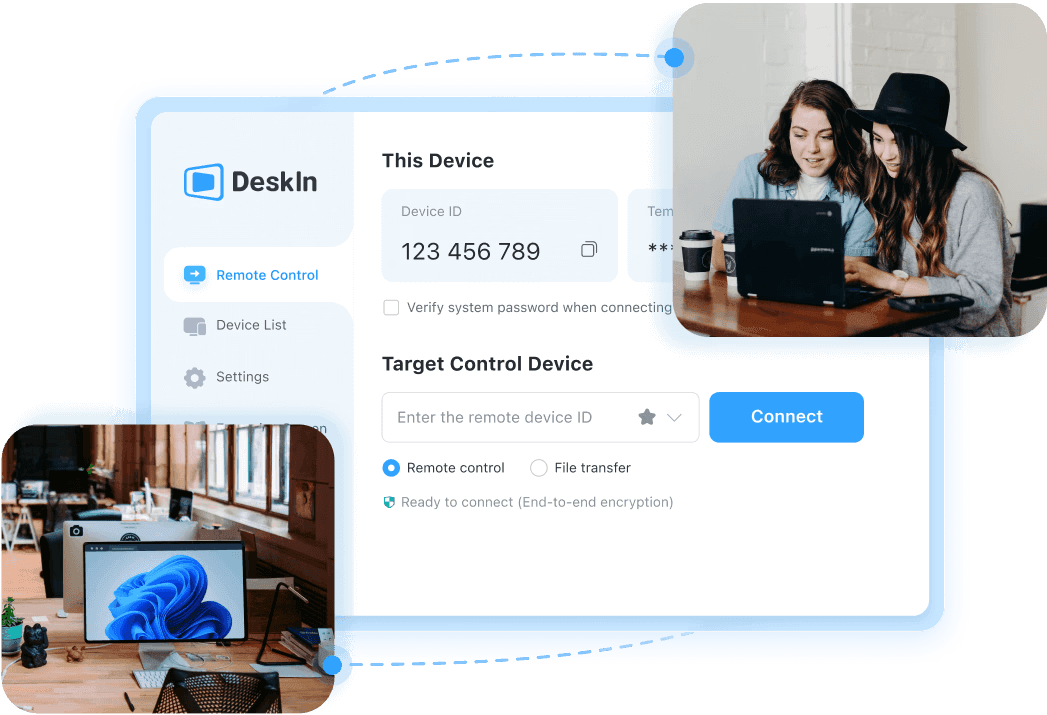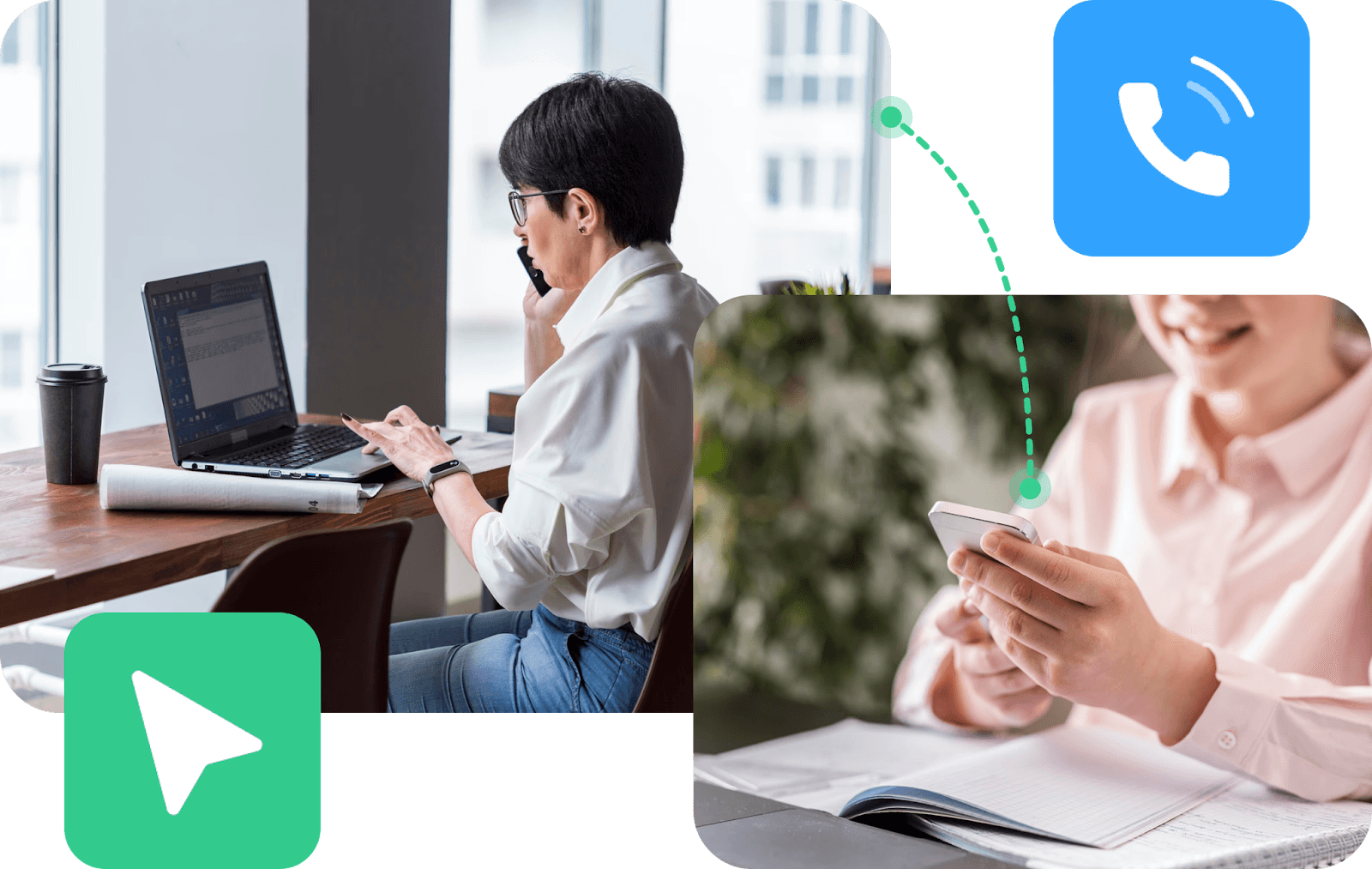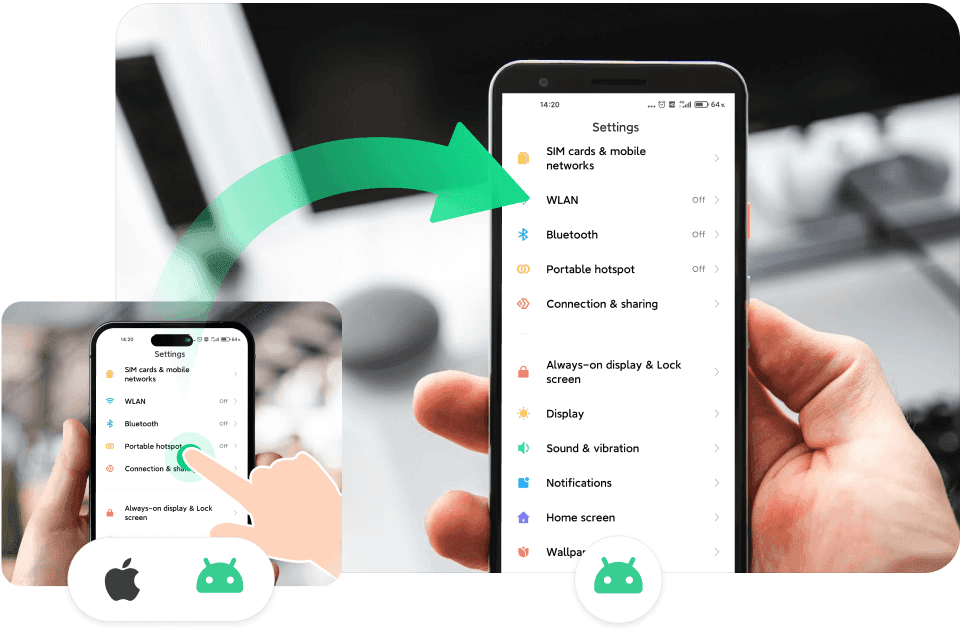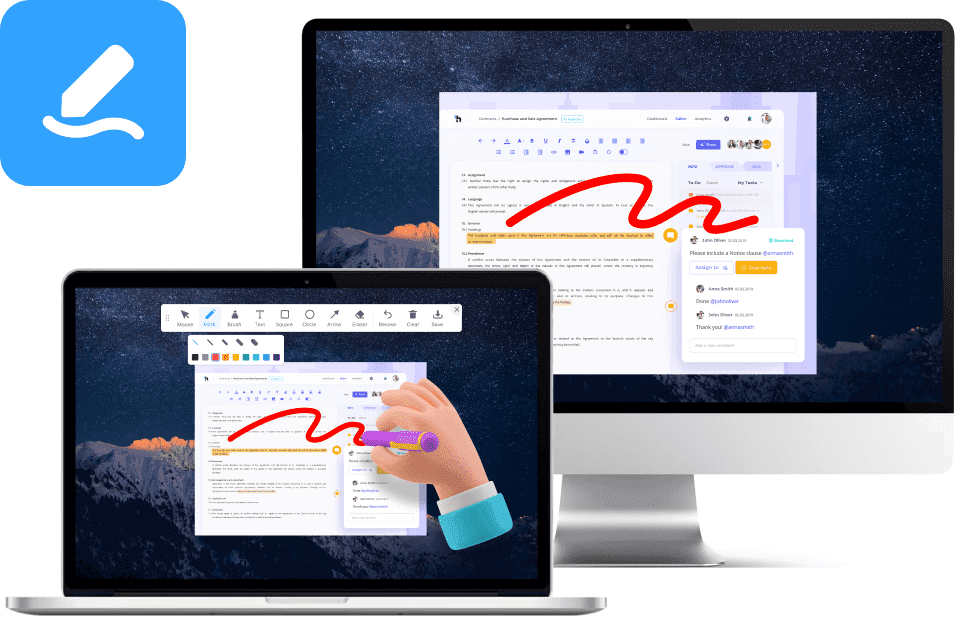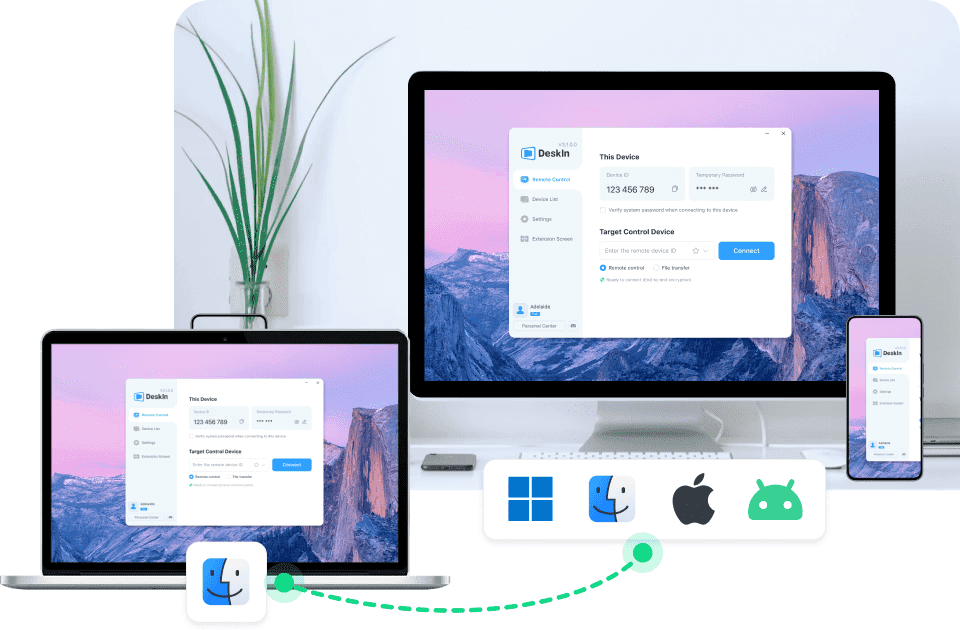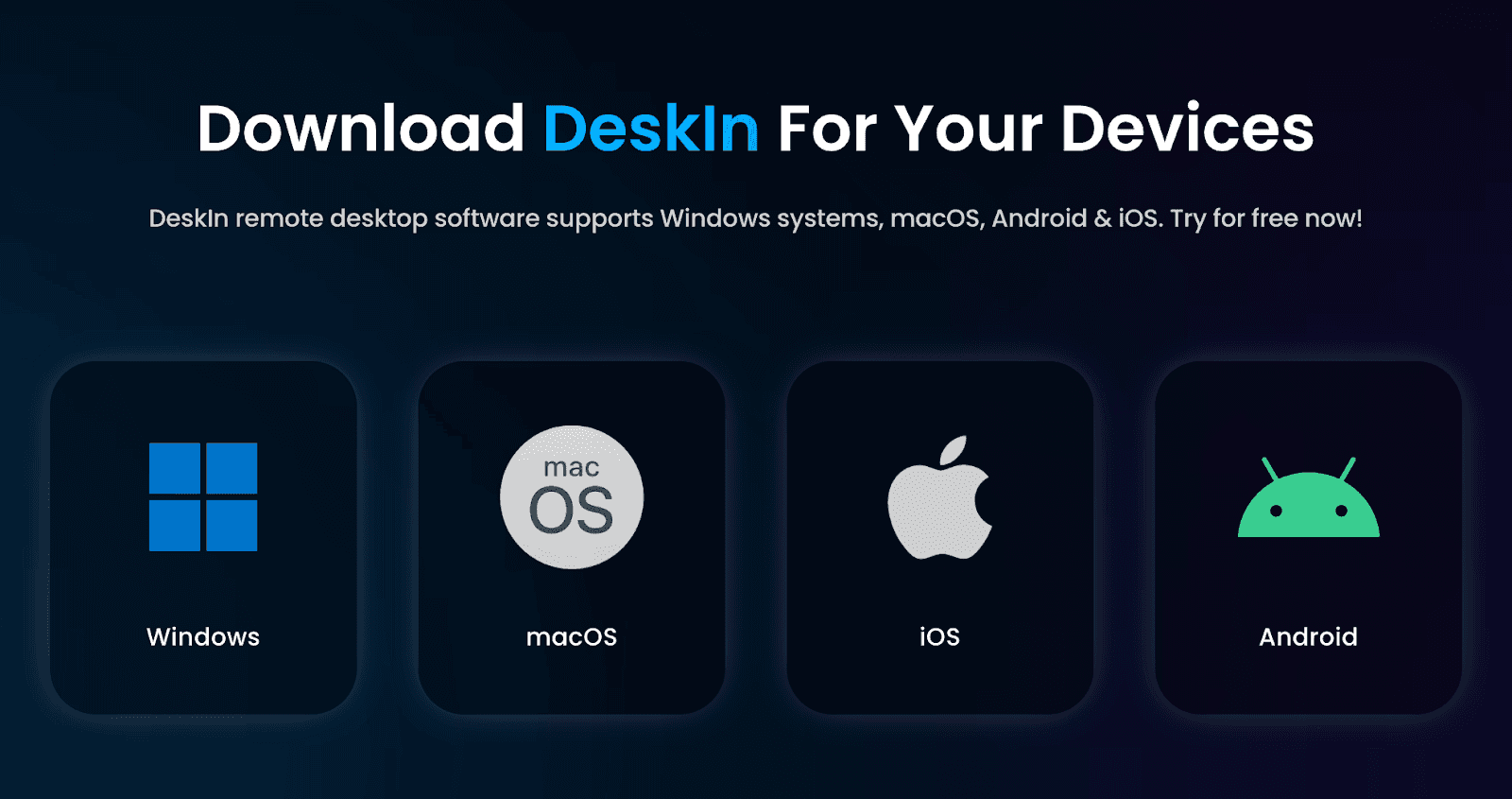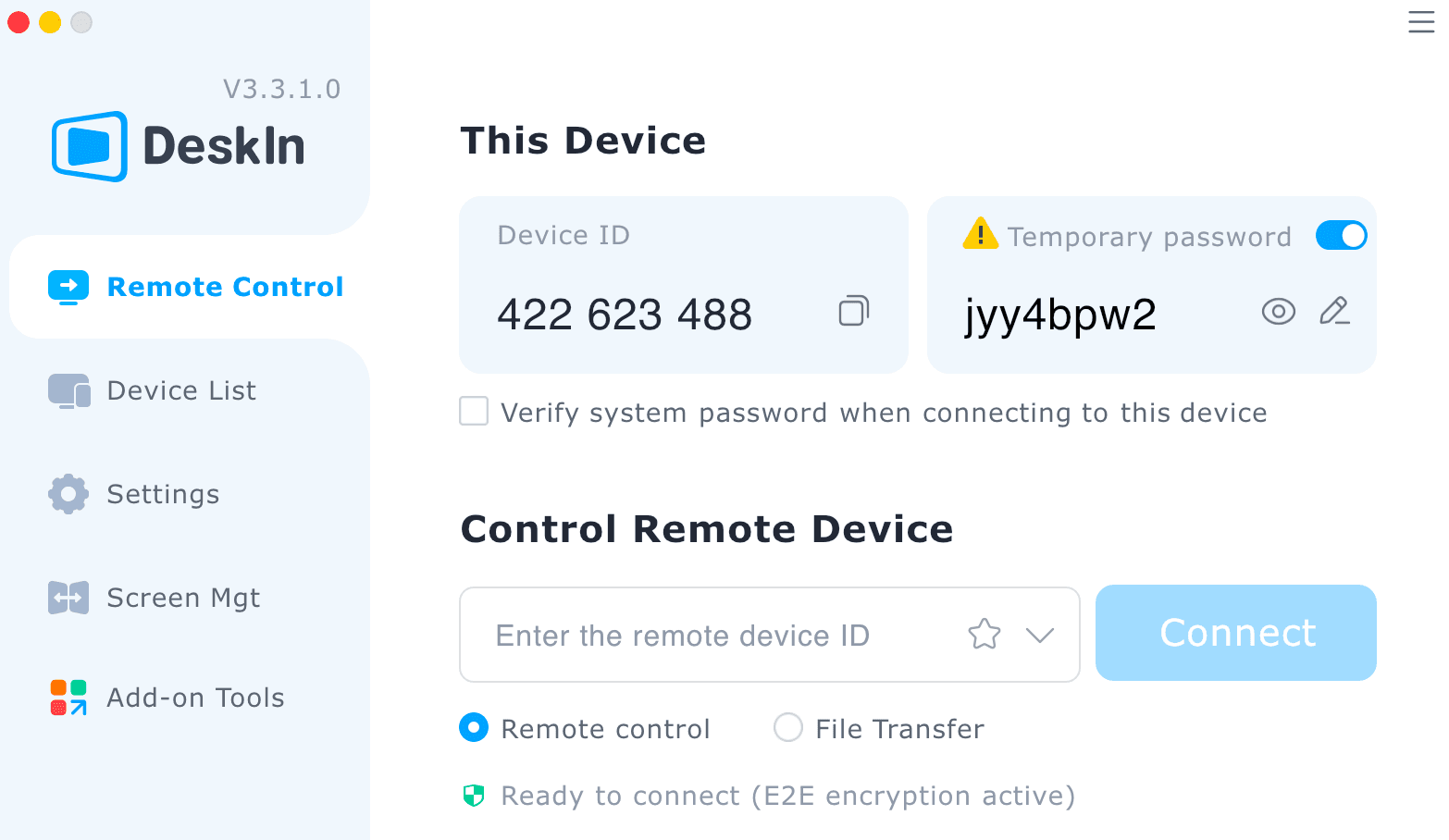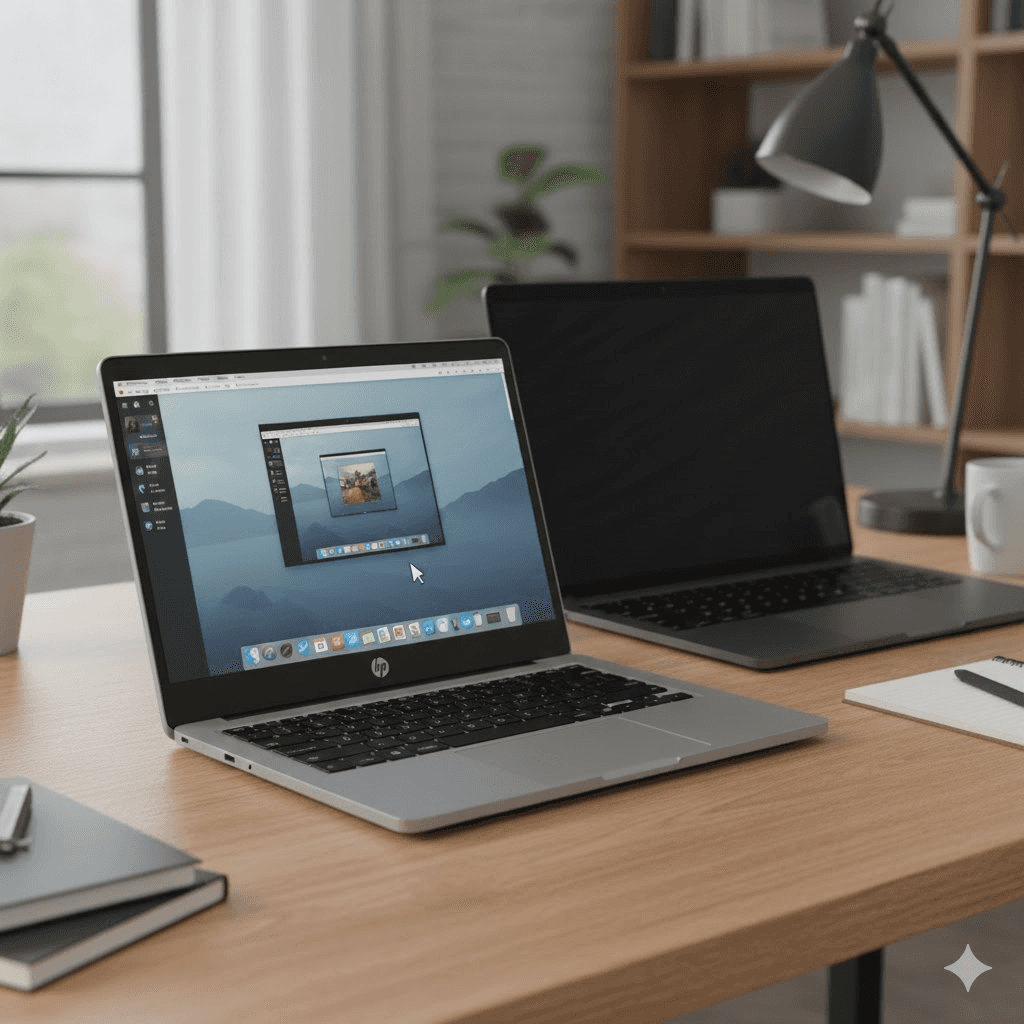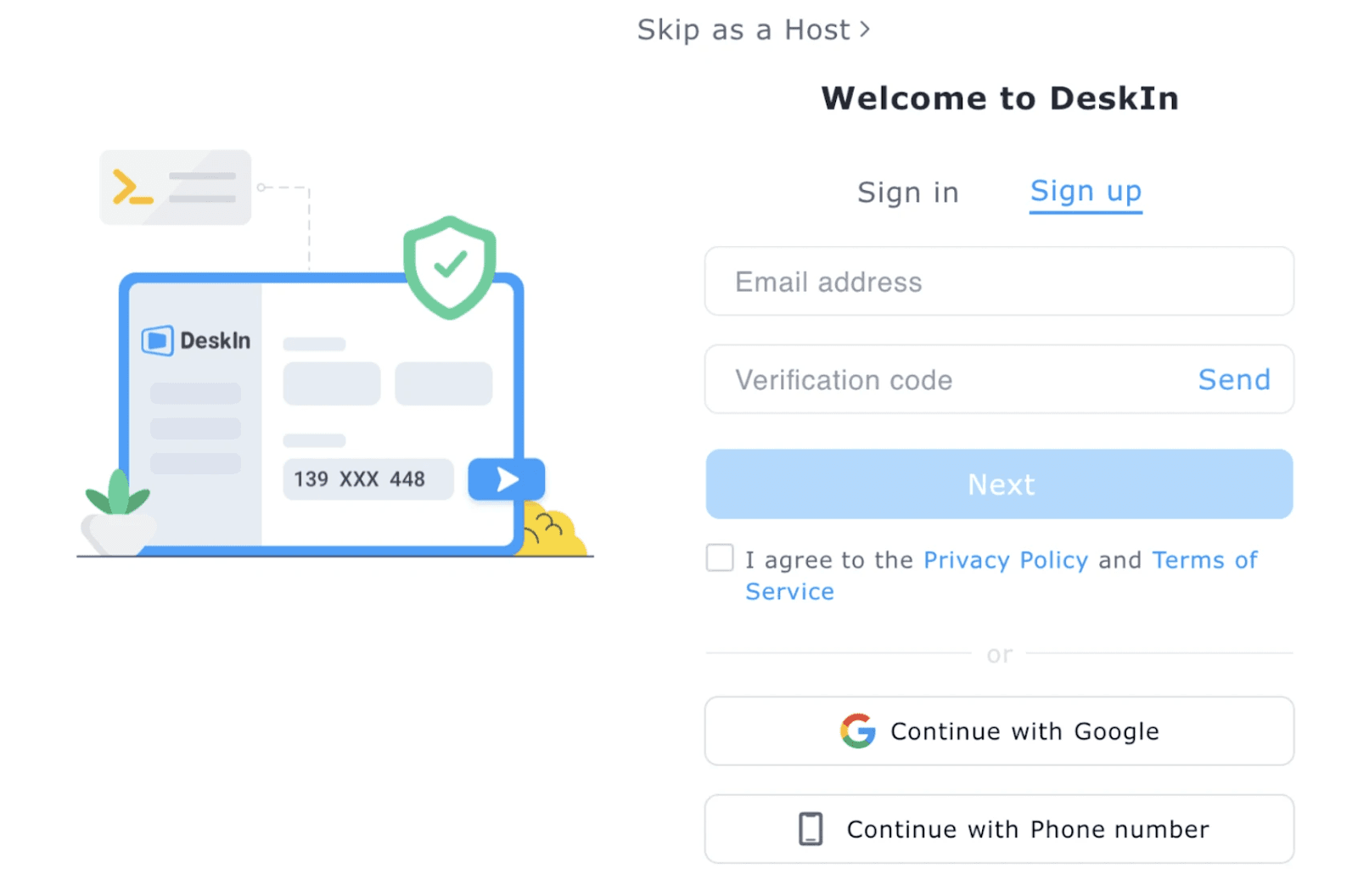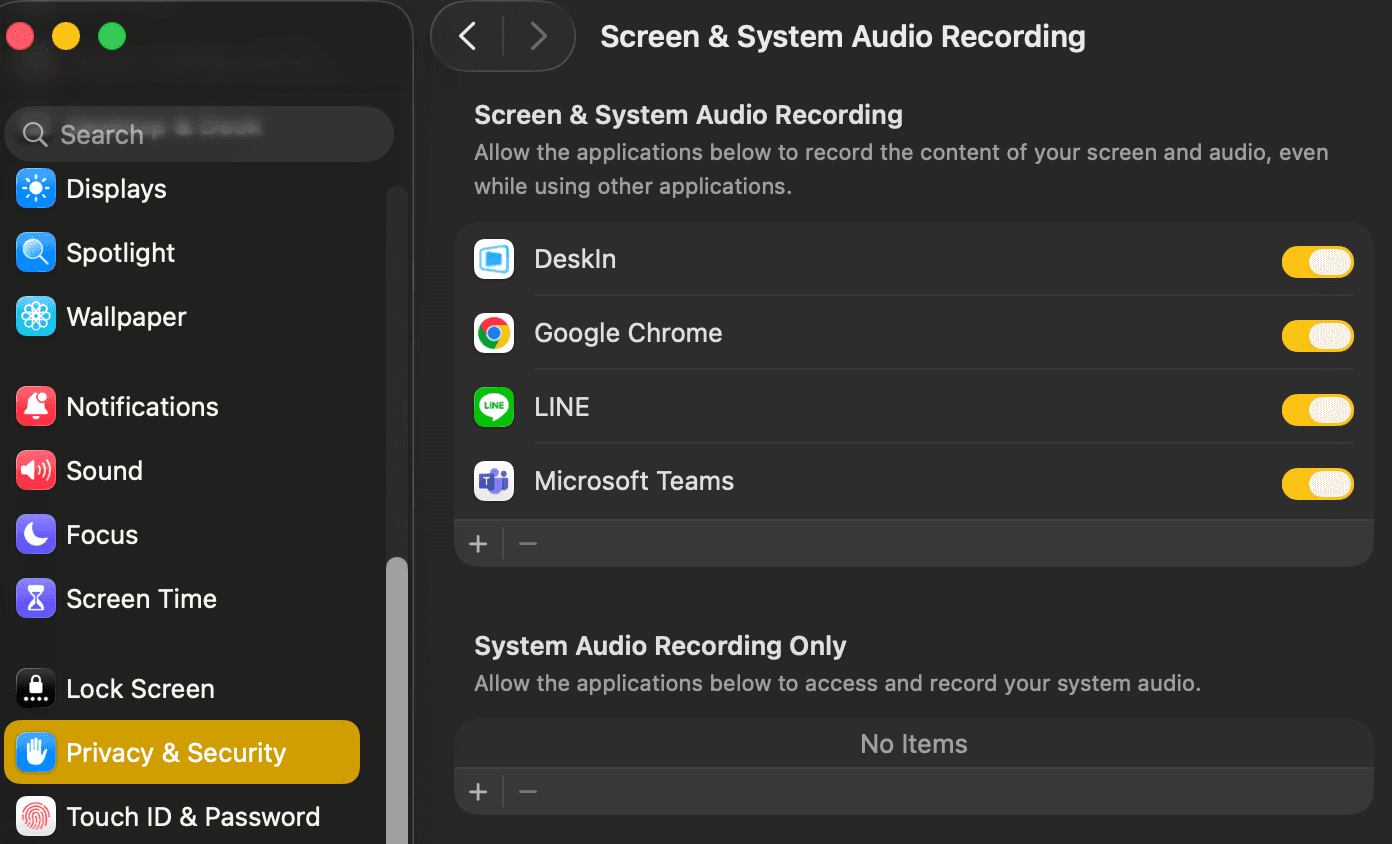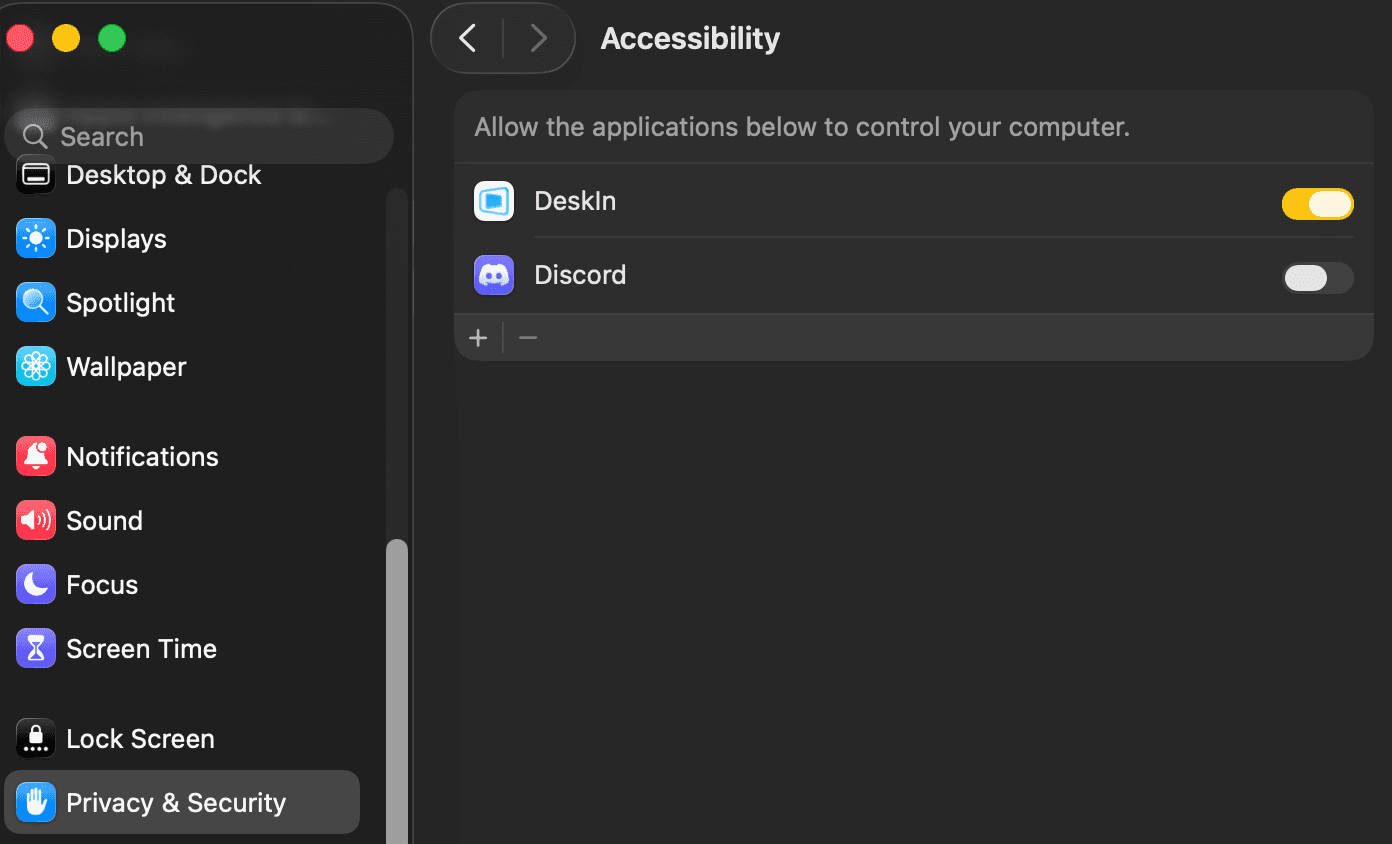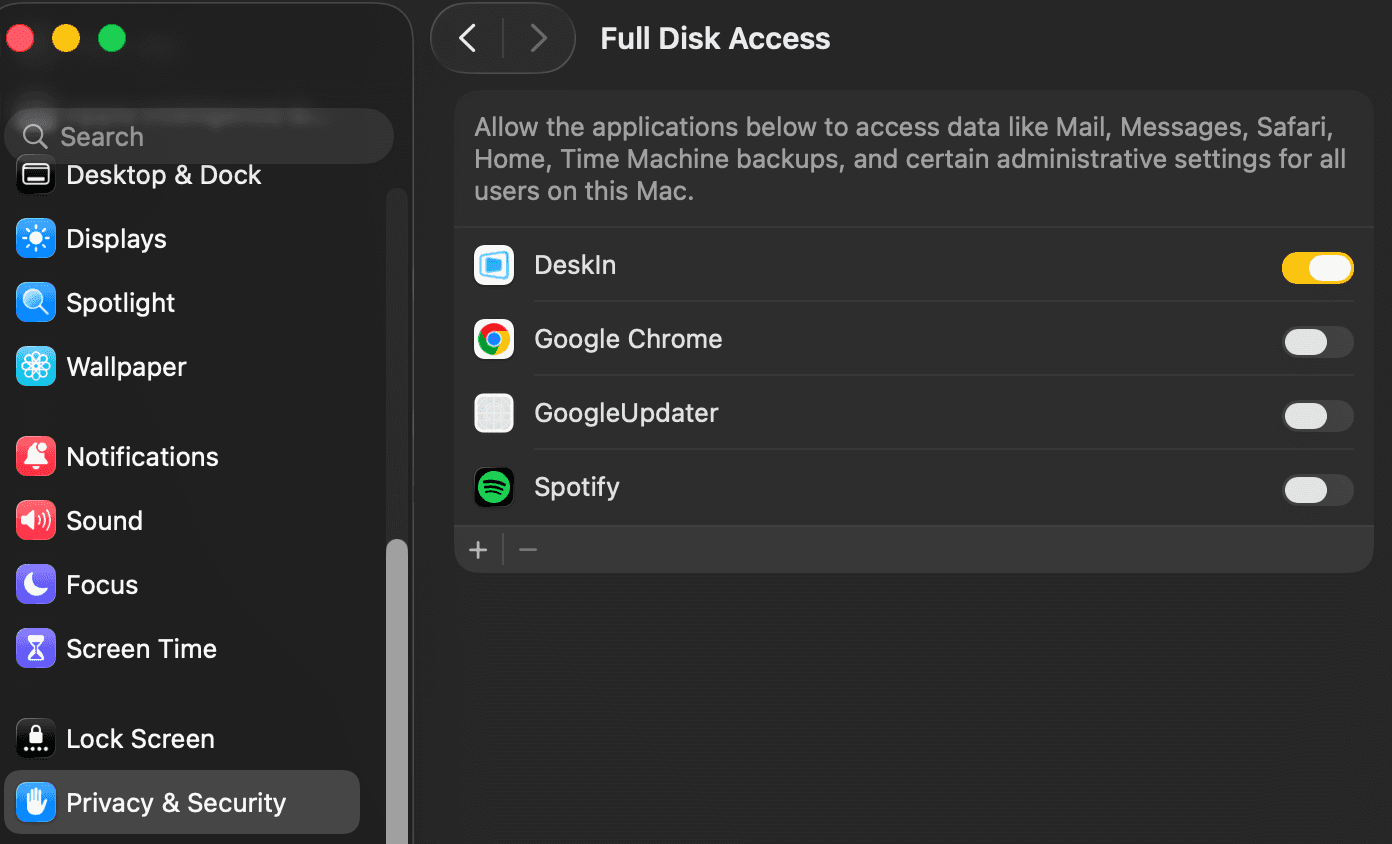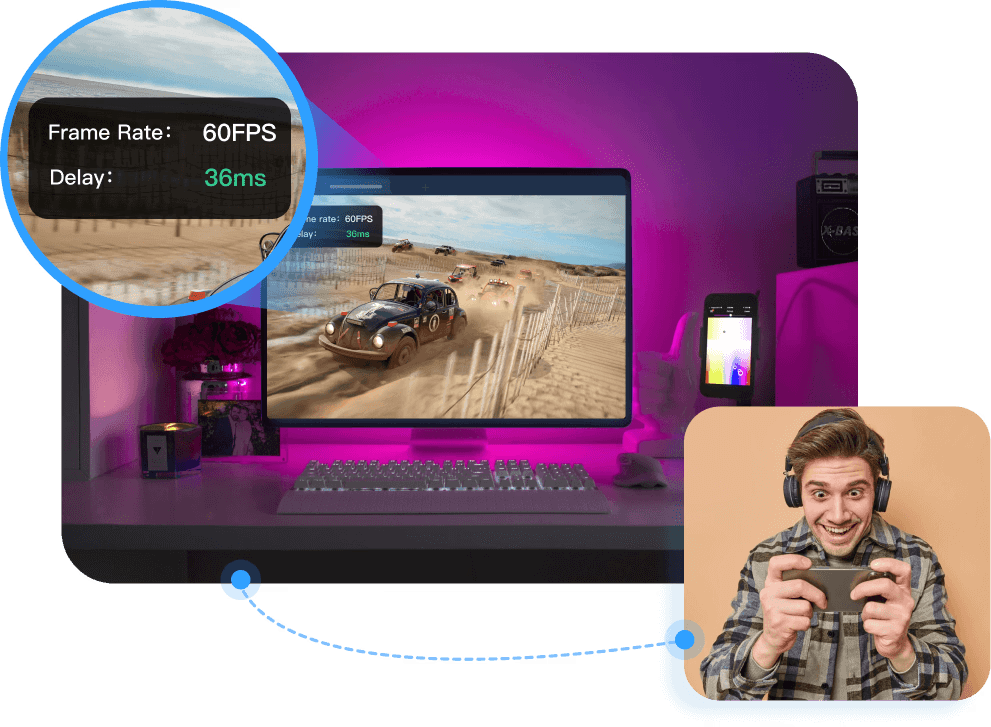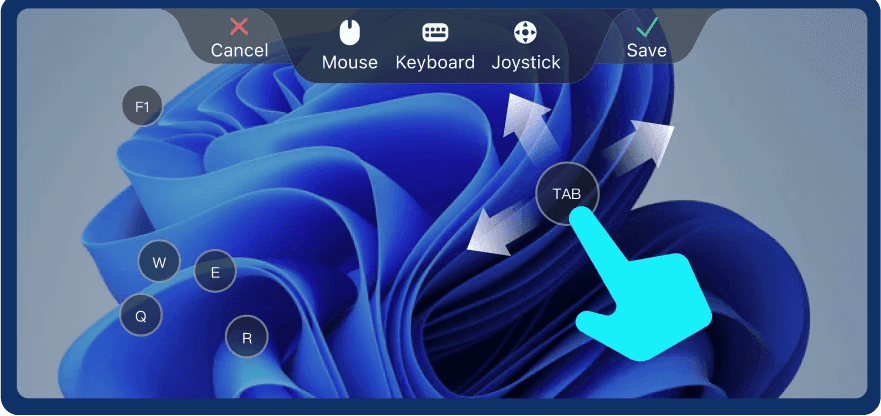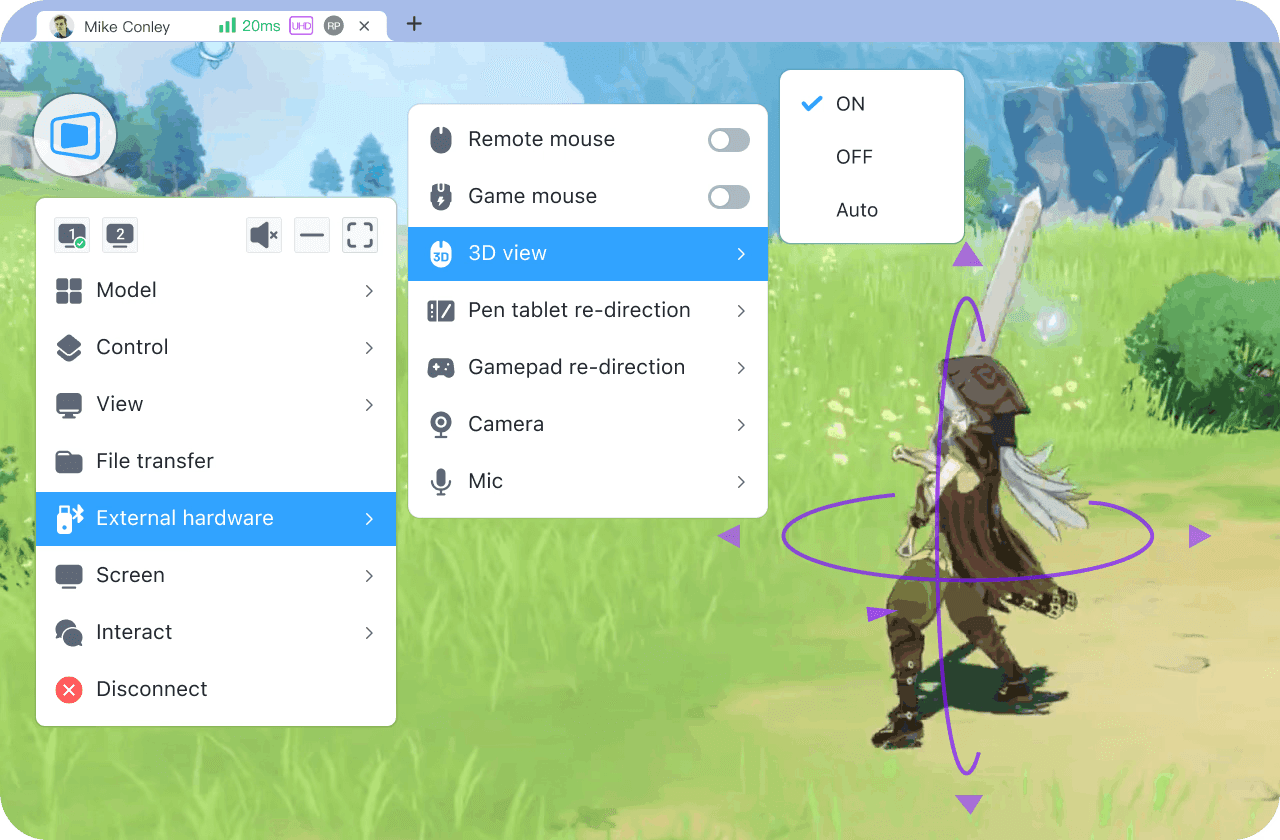我們都曾苦惱如何高效地投影安卓螢幕。經過測試無數工具後,我們整理出了將Android分享到電視、電腦以及其他手機的6個Android鏡像投影工具和方法,能解決你所有跨裝置分享安卓畫面的需求。無論追劇時鏡像安卓畫面到電視、客戶演示時將內容投射到大螢幕,或是遠端協助同事解決手機問題,這些工具都能輕鬆解決裝置相容性的問題。
從無線跨平台方案到Android內建功能,每款工具都針對不同使用情境優化,同時兼顧簡便性與效能。一起來看看這些能改變你投影方式的神器吧!
快速比較:最佳Android畫面分享方案
尋找最適合的安卓螢幕投影工具?以下根據不同需求推薦:
跨平台投影(Windows PC/iPhone/Android/macOS) → 使用 DeskIn

投射到 Google TV → 內建 Chromecast
非Google品牌智慧電視 → 三星/OnePlus手機用原生工具,其他推薦 ApowerMirror
無WiFi環境 → HDMI線或Miracast接收器
工具 | 優點 | 缺點 | 易用性 | 最佳情境 |
DeskIn | 跨平台支援、穩定清晰、無線投影 | 需安裝軟體 | ⭐⭐⭐⭐⭐ | PC/iPhone/Android/macOS鏡射 |
Chromecast | Google TV內建、流暢投射 | 僅限Google裝置、略有延遲 | ⭐⭐⭐⭐ | Google TV用戶 |
ApowerMirror | 支援多數電視、多裝置連線 | 免費版功能有限、偶爾延遲 | ⭐⭐⭐⭐ | 非Google智慧電視 |
HDMI線/Miracast接收器 | 無需網路、低延遲 | 需硬體支援、不便攜帶 | ⭐⭐ | 無WiFi環境 |
三星/OnePlus原生工具 | 免安裝、快速配對 | 品牌限定、功能較少 | ⭐⭐⭐⭐ | 三星/OnePlus用戶 |
Scrcpy/Vysor | USB穩定、免費(Scrcpy) | 設定複雜、iOS支援有限 | ⭐⭐ | 開發者/進階用戶 |

方法1:用DeskIn快速將Android畫面投影到PC/iPhone/Android(推薦!)
對於需要頻繁跨平台協作的團隊或個人,DeskIn 是最全面的Android鏡像投影工具。沒有網路和距離限制,就算不在同一網路,甚至距離很遠,DeskIn都能瞬間將Android、iPhone或筆電畫面投射到任何PC電腦、筆電、手機、平板裝置。不需要複雜設定,掃碼或輸入密碼就能投影,延遲低至40ms,4K高清,甚至內建語音通話、檔案傳輸功能,實現即時協作。
💡 為何選擇DeskIn?
4K畫質 & 40ms超低延遲:聲音畫面同步傳輸、設計檢閱或遊戲都流暢。
跨平台支援:Android、iOS、Windows、Mac皆可互連投影。
256位元加密:保證投影内容不會外泄。
即時註解 & 協作:可標記重點或同步文字。內建語音通話邊投影邊討論。
設定簡單靈活:可從任意一端發起螢幕投影請求,投影超快速。
完全免費使用!
📚你可能感興趣:
使用DeskIn無線投影安卓畫面到PC的操作步驟:
下載安裝DeskIn於手機與電腦,注冊登入相同帳號

用Android掃描電腦DeskIn上的QR code即可投影。也可在電腦/手機/平板透過輸入密碼配對,3秒内開始鏡像安卓畫面到電腦。
你甚至可以使用DeskIn内建的其他功能,用Android控制電腦、在PC操控安卓手機、在安卓或電腦之間互相傳輸檔案等等。

使用DeskIn無線投影安卓畫面到手機的操作步驟:
下載安裝DeskIn於兩隻手機,注冊登入相同帳號。
在要投影的安卓上打開DeskIn>>進入「本機」>>打開「允許連線本設備」>>點擊「授權手機投影」>>點擊「開始投影」
在接收投影畫面的手機DeskIn設備列表找到要投影的安卓,點擊連線輸入密碼即可。

💻很簡單吧!立即下載DeskIn輕鬆分享你的Android畫面。

方法2:透過Chromecast將Android畫面投射到Google TV
若你的電視是 Google TV,直接使用內建Chromecast功能即可分享Android手機畫面到電視。不需要額外的軟體,而且投影非常穩定,同樣支援高達4K畫質。注意安卓 4.4以下版本不支援此功能,且安卓和電視須在同一網路下。
使用Chromecast將Android畫面投射到Google TV的步驟:
手機頂部下拉打開快捷選單,點擊「投放」圖示。
選擇你的Google TV裝置(需同一WiFi)。
點擊「立即開始」,手機畫面即鏡射到電視。
⚠️ 注意:部分DRM保護內容(如Netflix)可能無法全螢幕投影。

方法3:用ApowerMirror投影到非Google電視或PC
ApowerMirror 是分享安卓畫面的彈性選擇,支援無線/USB連接,適合不穩定的網路環境。如果你的電視不支援chromecast,你可以使用ApowerMirror將Android畫面投影到電視。免費版本支援1080p畫質,若需要高畫質或螢幕錄影則需要付費解鎖。
用ApowerMirror投影安卓畫面到電視或PC的步驟:
安卓上下載ApowerMirror App。
安卓與電視/電腦連接同一WiFi。
點擊ApowerMirror上藍色鏡射按鈕,選擇電視名稱或掃描電視上的QR碼進行投影。

方法4:無WiFi時用HDMI線或Miracast接收器
若環境無網路,可透過 USB-C轉HDMI線 或 Miracast接收器 直接投影安卓畫面到電視,適合播放離線影片。
要求:
支援DisplayPort Alt Mode的Android手機
USB-C轉HDMI轉接器
電視HDMI埠
用HDMI線或Miracast接收器投影安卓畫面的步驟:
確認手機支援USB-C 視訊輸出。
連接手機、轉接器、HDMI線還有電視。
切換電視至正確HDMI輸入源。

方法5:三星/OnePlus手機內建鏡射功能
三星用戶可用 Smart View,OnePlus用戶則用 Cast 功能,直接鏡像安卓畫面到電視,無需安裝App。
使用内建工具投影三星畫面操作步驟:
手機與電視/電腦連同一WiFi。
下拉快捷選單,點擊「Smart View」。
選擇電視/電腦名稱,確認連線。

方法6:USB有線投影(Scrcpy/Vysor)
需超低延遲時,可用 Scrcpy(免費)或 Vysor 透過USB投影安卓畫面到電腦,適合開發者。
使用Scrcpy等有線方式投影安卓畫面的步驟:
下載Scrcpy並解壓縮。
啟用手機「USB偵錯」模式。
前往“設定”>“關於手機”
點擊“版本號”7 次以解鎖“開發者選項”
返回“設定”>“開發者選項”>“啟用 USB 偵錯”
透過線材連接安卓裝置和電腦,執行scrcpy.exe。

如何解決 Android 螢幕鏡像投影失敗?
如果 Android 裝置上的螢幕鏡像功能無法正常運作,請嘗試以下方檢查:
Wi-Fi 問題:大部分投影工具需要兩台裝置連接到同一個穩定的 Wi-Fi 網路。如有需要,可嘗試重新啟動路由器或重新連接。你也可以選擇無需在同一網路也可以進行投影的螢幕鏡像工具DeskIn。
USB 偵錯:對於有線連接,請在「開發者選項」中啟用 USB 偵錯。
應用程式崩潰:清除快取或重新安裝鏡像應用程式。
相容性:檢查您的電視或目標裝置是否支援 Miracast 或您選擇的工具。
仍然卡住?請嘗試根據您的裝置類型切換到其他方法,最推薦使用無線跨平台螢幕投影工具DeskIn,立即下載試試吧!

投影Android螢幕時的常見問題
❓ 能否跨網絡鏡射?
→ 可以!DeskIn或Miracast支援本地連線,無需在同一網路也可投影,Miracast支援離線投影。
❓ 鏡射是否安全?
→ 推薦使用具256位元加密的工具(如DeskIn),避免敏感資料外洩。
結論:根據需求選擇最佳方案
本文提供了完整的的Android畫面投影到電視、電腦還有其他手機、平板的方法,將選擇哪種方法取決於你需要投影的裝置。
全能跨平台 → DeskIn(支援4K/低延遲/加密)
Google TV用戶 → Chromecast
三星/OnePlus用戶 → 原生鏡射工具
無WiFi環境 → HDMI線/Miracast
在以上幾種方法中,對於商務人士,DeskIn 憑藉其軍規加密、跨平台相容性及直覺操作,成為遠端協作的首選。
💻立即下載DeskIn,體驗無縫的安卓畫面分享吧!

我們都曾苦惱如何高效地投影安卓螢幕。經過測試無數工具後,我們整理出了將Android分享到電視、電腦以及其他手機的6個Android鏡像投影工具和方法,能解決你所有跨裝置分享安卓畫面的需求。無論追劇時鏡像安卓畫面到電視、客戶演示時將內容投射到大螢幕,或是遠端協助同事解決手機問題,這些工具都能輕鬆解決裝置相容性的問題。
從無線跨平台方案到Android內建功能,每款工具都針對不同使用情境優化,同時兼顧簡便性與效能。一起來看看這些能改變你投影方式的神器吧!
快速比較:最佳Android畫面分享方案
尋找最適合的安卓螢幕投影工具?以下根據不同需求推薦:
跨平台投影(Windows PC/iPhone/Android/macOS) → 使用 DeskIn

投射到 Google TV → 內建 Chromecast
非Google品牌智慧電視 → 三星/OnePlus手機用原生工具,其他推薦 ApowerMirror
無WiFi環境 → HDMI線或Miracast接收器
工具 | 優點 | 缺點 | 易用性 | 最佳情境 |
DeskIn | 跨平台支援、穩定清晰、無線投影 | 需安裝軟體 | ⭐⭐⭐⭐⭐ | PC/iPhone/Android/macOS鏡射 |
Chromecast | Google TV內建、流暢投射 | 僅限Google裝置、略有延遲 | ⭐⭐⭐⭐ | Google TV用戶 |
ApowerMirror | 支援多數電視、多裝置連線 | 免費版功能有限、偶爾延遲 | ⭐⭐⭐⭐ | 非Google智慧電視 |
HDMI線/Miracast接收器 | 無需網路、低延遲 | 需硬體支援、不便攜帶 | ⭐⭐ | 無WiFi環境 |
三星/OnePlus原生工具 | 免安裝、快速配對 | 品牌限定、功能較少 | ⭐⭐⭐⭐ | 三星/OnePlus用戶 |
Scrcpy/Vysor | USB穩定、免費(Scrcpy) | 設定複雜、iOS支援有限 | ⭐⭐ | 開發者/進階用戶 |

方法1:用DeskIn快速將Android畫面投影到PC/iPhone/Android(推薦!)
對於需要頻繁跨平台協作的團隊或個人,DeskIn 是最全面的Android鏡像投影工具。沒有網路和距離限制,就算不在同一網路,甚至距離很遠,DeskIn都能瞬間將Android、iPhone或筆電畫面投射到任何PC電腦、筆電、手機、平板裝置。不需要複雜設定,掃碼或輸入密碼就能投影,延遲低至40ms,4K高清,甚至內建語音通話、檔案傳輸功能,實現即時協作。
💡 為何選擇DeskIn?
4K畫質 & 40ms超低延遲:聲音畫面同步傳輸、設計檢閱或遊戲都流暢。
跨平台支援:Android、iOS、Windows、Mac皆可互連投影。
256位元加密:保證投影内容不會外泄。
即時註解 & 協作:可標記重點或同步文字。內建語音通話邊投影邊討論。
設定簡單靈活:可從任意一端發起螢幕投影請求,投影超快速。
完全免費使用!
📚你可能感興趣:
使用DeskIn無線投影安卓畫面到PC的操作步驟:
下載安裝DeskIn於手機與電腦,注冊登入相同帳號

用Android掃描電腦DeskIn上的QR code即可投影。也可在電腦/手機/平板透過輸入密碼配對,3秒内開始鏡像安卓畫面到電腦。
你甚至可以使用DeskIn内建的其他功能,用Android控制電腦、在PC操控安卓手機、在安卓或電腦之間互相傳輸檔案等等。

使用DeskIn無線投影安卓畫面到手機的操作步驟:
下載安裝DeskIn於兩隻手機,注冊登入相同帳號。
在要投影的安卓上打開DeskIn>>進入「本機」>>打開「允許連線本設備」>>點擊「授權手機投影」>>點擊「開始投影」
在接收投影畫面的手機DeskIn設備列表找到要投影的安卓,點擊連線輸入密碼即可。

💻很簡單吧!立即下載DeskIn輕鬆分享你的Android畫面。

方法2:透過Chromecast將Android畫面投射到Google TV
若你的電視是 Google TV,直接使用內建Chromecast功能即可分享Android手機畫面到電視。不需要額外的軟體,而且投影非常穩定,同樣支援高達4K畫質。注意安卓 4.4以下版本不支援此功能,且安卓和電視須在同一網路下。
使用Chromecast將Android畫面投射到Google TV的步驟:
手機頂部下拉打開快捷選單,點擊「投放」圖示。
選擇你的Google TV裝置(需同一WiFi)。
點擊「立即開始」,手機畫面即鏡射到電視。
⚠️ 注意:部分DRM保護內容(如Netflix)可能無法全螢幕投影。

方法3:用ApowerMirror投影到非Google電視或PC
ApowerMirror 是分享安卓畫面的彈性選擇,支援無線/USB連接,適合不穩定的網路環境。如果你的電視不支援chromecast,你可以使用ApowerMirror將Android畫面投影到電視。免費版本支援1080p畫質,若需要高畫質或螢幕錄影則需要付費解鎖。
用ApowerMirror投影安卓畫面到電視或PC的步驟:
安卓上下載ApowerMirror App。
安卓與電視/電腦連接同一WiFi。
點擊ApowerMirror上藍色鏡射按鈕,選擇電視名稱或掃描電視上的QR碼進行投影。

方法4:無WiFi時用HDMI線或Miracast接收器
若環境無網路,可透過 USB-C轉HDMI線 或 Miracast接收器 直接投影安卓畫面到電視,適合播放離線影片。
要求:
支援DisplayPort Alt Mode的Android手機
USB-C轉HDMI轉接器
電視HDMI埠
用HDMI線或Miracast接收器投影安卓畫面的步驟:
確認手機支援USB-C 視訊輸出。
連接手機、轉接器、HDMI線還有電視。
切換電視至正確HDMI輸入源。

方法5:三星/OnePlus手機內建鏡射功能
三星用戶可用 Smart View,OnePlus用戶則用 Cast 功能,直接鏡像安卓畫面到電視,無需安裝App。
使用内建工具投影三星畫面操作步驟:
手機與電視/電腦連同一WiFi。
下拉快捷選單,點擊「Smart View」。
選擇電視/電腦名稱,確認連線。

方法6:USB有線投影(Scrcpy/Vysor)
需超低延遲時,可用 Scrcpy(免費)或 Vysor 透過USB投影安卓畫面到電腦,適合開發者。
使用Scrcpy等有線方式投影安卓畫面的步驟:
下載Scrcpy並解壓縮。
啟用手機「USB偵錯」模式。
前往“設定”>“關於手機”
點擊“版本號”7 次以解鎖“開發者選項”
返回“設定”>“開發者選項”>“啟用 USB 偵錯”
透過線材連接安卓裝置和電腦,執行scrcpy.exe。

如何解決 Android 螢幕鏡像投影失敗?
如果 Android 裝置上的螢幕鏡像功能無法正常運作,請嘗試以下方檢查:
Wi-Fi 問題:大部分投影工具需要兩台裝置連接到同一個穩定的 Wi-Fi 網路。如有需要,可嘗試重新啟動路由器或重新連接。你也可以選擇無需在同一網路也可以進行投影的螢幕鏡像工具DeskIn。
USB 偵錯:對於有線連接,請在「開發者選項」中啟用 USB 偵錯。
應用程式崩潰:清除快取或重新安裝鏡像應用程式。
相容性:檢查您的電視或目標裝置是否支援 Miracast 或您選擇的工具。
仍然卡住?請嘗試根據您的裝置類型切換到其他方法,最推薦使用無線跨平台螢幕投影工具DeskIn,立即下載試試吧!

投影Android螢幕時的常見問題
❓ 能否跨網絡鏡射?
→ 可以!DeskIn或Miracast支援本地連線,無需在同一網路也可投影,Miracast支援離線投影。
❓ 鏡射是否安全?
→ 推薦使用具256位元加密的工具(如DeskIn),避免敏感資料外洩。
結論:根據需求選擇最佳方案
本文提供了完整的的Android畫面投影到電視、電腦還有其他手機、平板的方法,將選擇哪種方法取決於你需要投影的裝置。
全能跨平台 → DeskIn(支援4K/低延遲/加密)
Google TV用戶 → Chromecast
三星/OnePlus用戶 → 原生鏡射工具
無WiFi環境 → HDMI線/Miracast
在以上幾種方法中,對於商務人士,DeskIn 憑藉其軍規加密、跨平台相容性及直覺操作,成為遠端協作的首選。
💻立即下載DeskIn,體驗無縫的安卓畫面分享吧!


Play x Work
All at Once
DeskIn Remote Game
only $14.32 USD 🎉 Limited on July 16-31
Add promo code: deskinsummer1





